President Donald Trump signed a bill Monday evening ending the three-day government shutdown.
The bill funds the government for an additional 17 days, until Feb. 8, while funding the Children’s Health Insurance Program (CHIP) for another six years.
Senate Democrats reluctantly voted in favor to resume government operations earlier on Monday, and then the House of Representatives passed the legislation, which put it on Trump’s desk. Additional time will be needed to negotiate immigration reform before the Feb. 8 deadline.

The Associated Press (Twitter)
In return for helping end the government shutdown, Senate Majority Leader Mitch McConnell agreed to negotiations over immigration proposals and a fix to the Deferred Action Childhood Arrivals (DACA) program.
Hundreds of thousands of federal workers will return to work on Tuesday.
Earlier Monday, the U.S. Senate procured enough votes from Republicans and Democrats to end the three-day government shutdown that began Friday at midnight.
A compromise was reached, and many Democrats – who were holding the temporary budget hostage over immigration reform – changed their votes to support the compromise. The vote was overwhelming, 81 “yea” votes to 18 “nay” votes.
Approval for funding was stalled in Congress, where Republicans tried to garner support for a bipartisan agreement while Democrats initially refused to budge on immigration issues.
During a government shutdown, military service members and government employees are furloughed and paid retroactively when normal operations of the government are resumed. An extended shutdown can significantly impact the military and other “essential government workers,” as the government then runs late on bills and many other obligations.
Right before the 2013 government shutdown, then-President Barack Obama signed the Pay Our Military Act, which ensured that military service members got paid during the shutdown.
The military has an unfortunate history of having to deal with stopgap budgets – the Defense Department has been forced to operate under continuing resolutions, or CRs – short-term budgets while a longer-term budget is created – for the past nine years, rather than have an actual yearly budget.
Chairman of the Joint Chiefs of Staff Marine Gen. Joe Dunford said last week that the Defense Department needs “stability and predictability.”
“A CR this year would be below the level of projected funding,” he said. “In other words, the ’18 budget would be a decrease in what the President’s projected budget would be.” This would mean a lower spending level for the military, not to mention that the department would be going four months into fiscal year 2018 at that lower budget.
The current CR ran out at midnight on Friday, Jan. 19.
“This is the ninth straight year with a continuing resolution,” Dunford said. “That lack of predictability and that lack of stability in the budget has not allowed us to most efficiently plan and use the resources available to us.”
Trump in December signed the National Defense Authorization Act (NDAA), which will give the U.S. Military its largest pay raise in seven years, since 2010.
The NDAA calls for a $700 billion Pentagon budget and includes a 2.4-percent pay raise for troops, an increase in the number of troops, and increased spending for aircraft and ships as part of the Fiscal Year 2018 budget.
The NDAA sets the budget but does not provide funding, which Congress must do and is struggling to do. Trump urged Congress to pass legislation that will fund the defense budget in full.
The budget calls for an additional 20,000 troops; funding for weapons systems, retention pay and bonuses; and repairs for Navy ships such as the USS John S. McCain and the USS Fitzgerald, which were both involved in deadly collisions last year.
This is the largest proposed military budget to date, particularly the most significant budget to be passed during the wars in Iraq and Afghanistan.
Congress still has to come up with a definitive plan to fund the $700 billion budget. It has has to approve a defense budget cap increase – the Department of Defense Appropriations Act – in order to accommodate the proposed NDAA. The Act has already been passed in the House.



